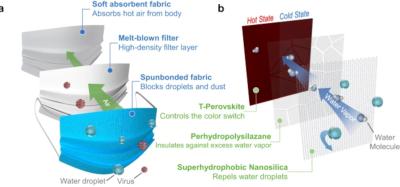Researchers develop triple-junction perovskite–perovskite–silicon solar cell with power conversion efficiency of 24.4%
Researchers at the Karlsruhe Institute of Technology (KIT), Institute for Solar Energy Research Hamelin (ISFH) and Leibniz University Hannover have designed triple-junction perovskite–perovskite–silicon solar cells with a record power conversion efficiency of 24.4%.
Schematic of the solar cell. Image from Energy & Environmental Science
Optimizing the light management of each perovskite sub-cell (∼1.84 and ∼1.52 eV for top and middle cells, respectively), the team maximized the current generation up to 11.6 mA cm−2. Key to this achievement was the development of a high-performance middle perovskite sub-cell, employing a stable pure-α-phase high-quality formamidinium lead iodide perovskite thin film (free of wrinkles, cracks, and pinholes). This enabled a high open-circuit voltage of 2.84 V in a triple junction. Non-encapsulated triple-junction devices retain up to 96.6% of their initial efficiency if stored in the dark at 85 °C for 1081 h.








